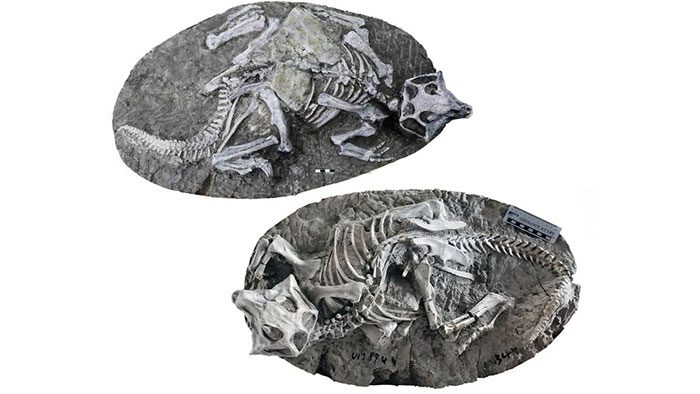Scientists have recently discovered what makes Yixian a place where the dinosaur world seems to be frozen in time.
Yixian is a formation from the early Cretaceous period in northeastern China, often referred to as the “Pompeii of the Dinosaurs” due to its preservation of some of the highest quality fossils in the world.
In most places around the globe, dinosaur skeletons are typically found in fragmented, missing many pieces, heavily damaged, or compressed into flat rock slabs…
However, in Yixian, dinosaurs have been discovered with completely intact 3D skeletons, maintaining the same posture they had while alive, and even retaining some soft tissue.

Two of the dinosaur skeletons excavated from Yixian, featuring extremely rare intact 3D fossils – (Photo: Chinese Academy of Sciences).
According to Live Science, the previously popular hypothesis regarding the formation of Yixian was that it resulted from a powerful volcanic disaster similar to the catastrophe that buried the ancient Roman city of Pompeii 2,000 years ago.
In Pompeii, the terrifying amount of ash from the eruption of Mount Vesuvius caused people and everything else to almost instantly die and be “fossilized” in their final postures.
However, new evidence suggests that the “Pompeii of the Dinosaurs” may have formed in a different manner.
A paper published in the scientific journal PNAS indicates a less catastrophic cause: These dinosaurs may have been buried in collapsed caves.
To find evidence, scientists analyzed zircon samples taken from some of the best-preserved fossils.
Zircon is a mineral that typically forms in volcanic rock and fossils, retaining uranium as it forms while excluding lead. Uranium is radioactive and decays slowly into lead over millions of years.
By measuring the ratio of uranium to lead in zircon, scientists determined that the fossils in the Yixian formation were deposited rapidly around 125.8 million years ago.
However, this occurred over a timeframe of only 93,000 years, significantly shorter than previously thought.
During this period, three wet weather events caused sediments to accumulate in lakes and on land much faster than expected.
This rapid accumulation buried many deceased organisms quickly, and the oxygen that typically promotes decay was cut off.
This effect was most pronounced in lakes, where sediment accumulated so quickly that soft tissues could be well-preserved in fine detail.
According to paleontologist Paul Olsen from Columbia University’s Lamont-Doherty Earth Observatory, the lead author, this scenario is much more plausible than the hypothesis that the dinosaurs were engulfed by fast-moving volcanic mudflows.
“The mudflows are extremely violent and capable of tearing apart any living or dead organism in their path,” Dr. Olsen explained.


















































